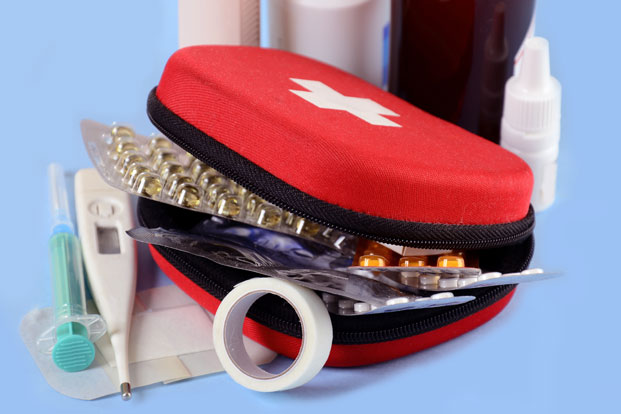Hydrogen peroxide and rubbing alcohol have much in common. From wound treatments to disinfectants, people seem to think the products are interchangeable.
Not true. In fact, they are chemically different and possess different properties. And here’s the real shocker: Many medical professionals believe that using either to clean an injury area is actually a bad thing because they may harm tissue and delay healing.
Hydrogen Peroxide
Hydrogen peroxide is a compound of oxygen and hydrogen. Its chemical symbol is H202, and many scientists refer to it as oxygenated water. It has become a staple of modern medicine cabinets, used to treat the scrapes, cuts and minor injuries that occur from playing, running, working and simply living.
The type of hydrogen peroxide sold in stores is formulated for home use and diluted to 3 percent to 10 percent of its pure form. That’s according to the AOCS, a trade organization that promotes the fats, oils, surfactants and related industrial materials. The AOCS puts annual hydrogen peroxide consumption at roughly 2 million tons in the United States.
Beyond its use as medicine, it used in jet fuel, as a bleaching agent on wool and human hair, an industrial cleaning solvent, a teeth bleaching agent, a water purifier in industrial settings, and for etching in manufacturing.
Rubbing Alcohol
Rubbing alcohol is a form of ethyl alcohol. The rubbing alcohol used at home is called isopropyl alcohol and is very poisonous, which means you can’t consume it. Instead, it is used occasionally as a rubdown lubricant for massages and once was used as a low-tech fever reducer, because it would dissolve on skin and presumably lower body temperature.
Caution should be exercised with rubbing alcohol because it is extremely flammable. It is used for disinfectant purposes when prepping instruments for surgery, and doctors use it to cleanse their hands in the same situation. It also can be used to clean electronic instruments and other delicate parts.
Misusing Alcohol and Peroxide
While both are disinfectants, there is a universal belief that disinfectants can be used on just about anything. That’s particularly true with hydrogen peroxide, which has some truly bizarre uses associated with it. The issue is that neither is a miracle substance, and both can present potential danger if used improperly. Which you choose to use matters little, and both have the major potential for misuse, thanks to their easy access and murky folklore on their properties.
Don’t Try This at Home
For example, hydrogen peroxide fans have advocated using it as way to clear sinus passages or as a douche to prevent yeast infections. Before you do that, you should read the cautions that the Centers for Disease Control and Prevention have issued. They note that hydrogen peroxide’s standard household formulas can irritate the skin and mucous membranes.
In extreme cases, hydrogen peroxide misuse can cause serious problems and may even be fatal. There are camps that believe it cures canker sores, boils, foot fungus and infections. But even more troubling are those who believe ingesting it orally can cure major diseases like cancer and AIDS. Beyond the fact that there’s no medical proof of its curative powers in those cases, it can cause vomiting, burns to the throat and stomach, and breathing difficulties if swallowed. Ingesting it can form oxygen bubbles that hamper blood flow. This so-called “Oxygen Therapy” has been debunked by no less an authority than the American Cancer Society, which warns that several people who have tried it have died.
Rubbing alcohol presents the same dire consequences. Some alcoholics drink it, believing that it can get them high. This practice can be fatal because isopropyl alcohol is a totally different chemical than the ethyl alcohol that is present in beer, wine and liquor. Just eight ounces of rubbing alcohol can be fatal, and the lucky ones who survive may sustain serious liver damage and even permanent blindness.
Inhaling its fumes is also serious business. Those experimenting with drugs often try huffing the fumes, believing alcohol vapors will reach their lungs and quickly render them into the same stupor that ethyl alcohol provides.
The problem is that isopropyl alcohol can irritate the lungs, particularly if the user is already asthmatic or suffers from COPD. Inhalation can cause a coughing fit and weaken the membranes lining the lungs.
The other problems associated with huffing are headaches caused by the powerful fumes and the fact that isopropyl alcohol is a potential carcinogen that targets the stomach. The isopropyl alcohol is metabolized into acetone, a poisonous substance that can stay in the body for a long time.
Instead of Peroxide or Alcohol
Somehow, because of the legends about its cleaning properties, both hydrogen peroxide and rubbing alcohol became part of the common wisdom. If little Johnny fell on the playground, Dad snagged his hand in the shop, or Mom cut her finger, it was time to reach for a bottle of one or the other.
But the best treatment for minor injuries and cuts is just to treat them with cool running water and soap, removing dirt and debris and conveniently washing away the bacteria. At that point, it is recommended to use an antibiotic ointment and a bandage. This keeps the wound area moist, which promotes healing, and keeps the bandage from sticking.
Hydrogen peroxide and rubbing alcohol have their uses. But the scope of their powers is limited, and certainly neither substance is meant for human consumption. Choose either if you need a good cleanser for your table, but keep in mind the dangers of both.

Leave a Reply